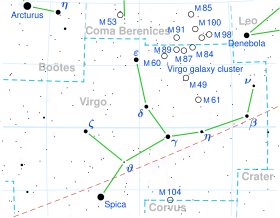Omega Virginis
| Observation data Epoch J2000 Equinox J2000 | |
|---|---|
| Constellation | Virgo |
| Right ascension | 11h 38m 27.60727s[1] |
| Declination | +08° 08′ 03.4663″[1] |
| Apparent magnitude (V) | 5.23 - 5.50[2][3] |
| Characteristics | |
| Evolutionary stage | AGB[4] |
| Spectral type | M4 III[5] |
| U−B color index | +1.63[6] |
| B−V color index | +1.60[6] |
| Variable type | LB[2] or SR[3] |
| Astrometry | |
| Radial velocity (Rv) | +5.13±0.52[7] km/s |
| Proper motion (μ) | RA: −3.89[1] mas/yr Dec.: +5.30[1] mas/yr |
| Parallax (π) | 6.56 ± 0.36 mas[1] |
| Distance | 500 ± 30 ly (152 ± 8 pc) |
| Absolute magnitude (MV) | +0.2[8] |
| Details | |
| Mass | 1.55[9] M☉ |
| Radius | 70[10] R☉ |
| Luminosity | 1,515[11] L☉ |
| Surface gravity (log g) | 0.8[8] cgs |
| Temperature | 3,490[11] K |
| Metallicity [Fe/H] | −0.08[8] dex |
| Other designations | |
| Database references | |
| SIMBAD | data |
Omega Virginis (ω Vir, ω Virginis) is a solitary[5] star in the zodiac constellation Virgo. It has an apparent visual magnitude of +5.2,[5] which is bright enough to be faintly visible to the naked eye. Based upon an annual stellar parallax shift of 6.56 milliarcseconds,[1] it is located about 500 light years from the Sun.

This is a red giant star with a stellar classification of M4 III.[5] It is thought to be on the asymptotic giant branch (AGB), with shells of hydrogen and helium around a carbon-oxygen core.[4] After evolving away from the main sequence it has expanded to around 70 times the solar radius,[10] and now shines with 1,515 times the luminosity of the Sun.[11] The effective temperature of the outer atmosphere is 3,490 K.[11]
Omega Virginis is a semiregular variable with a brightness that varies over an amplitude of 0.28 with periods of 30 and 275 days.[14] The General Catalogue of Variable Stars gives the magnitude range as 5.23 to 5.50.[2] It was formally declared a variable star in 1972 following a 1969 study showing small-amplitude variations.[15][16]
References
- ^ a b c d e f van Leeuwen, F. (November 2007), "Validation of the new Hipparcos reduction", Astronomy and Astrophysics, 474 (2): 653–664, arXiv:0708.1752, Bibcode:2007A&A...474..653V, doi:10.1051/0004-6361:20078357, S2CID 18759600.
- ^ a b c Samus, N. N.; et al. (2017), "General Catalogue of Variable Stars", Astronomy Reports, 5.1, 61 (1): 80–88, Bibcode:2017ARep...61...80S, doi:10.1134/S1063772917010085, S2CID 125853869.
- ^ a b "Omega Vir". International Variable Star Index. AAVSO. Retrieved 2022-01-08.
- ^ a b Eggen, Olin J. (July 1992). "Asymptotic giant branch stars near the sun". Astronomical Journal. 104 (1): 275–313. Bibcode:1992AJ....104..275E. doi:10.1086/116239.
- ^ a b c d Eggleton, P. P.; Tokovinin, A. A. (September 2008), "A catalogue of multiplicity among bright stellar systems", Monthly Notices of the Royal Astronomical Society, 389 (2): 869–879, arXiv:0806.2878, Bibcode:2008MNRAS.389..869E, doi:10.1111/j.1365-2966.2008.13596.x, S2CID 14878976.
- ^ a b Mermilliod, J.-C. (1986), "Compilation of Eggen's UBV data, transformed to UBV (unpublished)", Catalogue of Eggen's UBV Data, SIMBAD, Bibcode:1986EgUBV........0M.
- ^ Famaey, B.; et al. (2009). "Spectroscopic binaries among Hipparcos M giants,. I. Data, orbits, and intrinsic variations". Astronomy and Astrophysics. 498 (2): 627–640. arXiv:0901.0934. Bibcode:2009A&A...498..627F. doi:10.1051/0004-6361/200810698. S2CID 18739721.
- ^ a b c Smith, V.V.; Lambert, D.L. (1986), "The chemical composition of red giants. II - Helium burning and the s-process in the MS and S stars", Astrophysical Journal, 311: 843–863, Bibcode:1986ApJ...311..843S, doi:10.1086/164823
- ^ Kervella, Pierre; Arenou, Frédéric; Thévenin, Frédéric (20 December 2021). "Stellar and substellar companions from Gaia EDR3". Astronomy & Astrophysics. 657: A7. arXiv:2109.10912. Bibcode:2022A&A...657A...7K. doi:10.1051/0004-6361/202142146. eISSN 1432-0746. ISSN 0004-6361.
- ^ a b Pasinetti Fracassini, L. E.; et al. (February 2001), "Catalogue of Apparent Diameters and Absolute Radii of Stars (CADARS) - Third edition - Comments and statistics", Astronomy and Astrophysics, 367 (2): 521–524, arXiv:astro-ph/0012289, Bibcode:2001A&A...367..521P, doi:10.1051/0004-6361:20000451, S2CID 425754.
- ^ a b c d McDonald, I.; et al. (2012), "Fundamental Parameters and Infrared Excesses of Hipparcos Stars", Monthly Notices of the Royal Astronomical Society, 427 (1): 343–57, arXiv:1208.2037, Bibcode:2012MNRAS.427..343M, doi:10.1111/j.1365-2966.2012.21873.x, S2CID 118665352.
- ^ "* ome Vir", SIMBAD, Centre de données astronomiques de Strasbourg, retrieved 2016-09-19.
- ^ "/ftp/cats/more/HIP/cdroms/cats". Centre de Données astronomiques de Strasbourg. Strasbourg astronomical Data Center. Retrieved 15 October 2022.
- ^ Glass, I. S.; Van Leeuwen, F. (2007), "Semiregular variables in the solar neighbourhood", Monthly Notices of the Royal Astronomical Society, 378 (4): 1543–1549, arXiv:0704.3150, Bibcode:2007MNRAS.378.1543G, doi:10.1111/j.1365-2966.2007.11903.x, S2CID 14332208.
- ^ Kukarkin, B. V.; Kholopov, P. N.; Kukarkina, N. P.; Perova, N. B. (1973). "59th Name-List of Variable Stars". Information Bulletin on Variable Stars. 834: 1. Bibcode:1973IBVS..834....1K.
- ^ Eggen, Olin J. (1969). "Light Variations of Small Amplitude in the Red Giants of the Disc Population". Information Bulletin on Variable Stars. 355 (355, #1. (IBVS Homepage)): 1. Bibcode:1969IBVS..355....1E.

